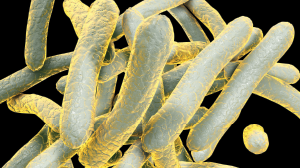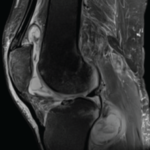
A 3D illustration of the bacterium, Mycobacterium tuberculosis.
Kateryna Kon/shutterstock.com
Pathologists are legendary for blending their work product with the culinary arts. Through the years, their use of delectable foods as descriptors has created a clever way to indelibly link in the minds of clinicians the histopathologic observations of disease with an assortment of these tasty foods: There is the depiction of an apple green birefringence when gazing at amyloid seeped tissue under the microscope, and at autopsy, the nutmeg appearance of an engorged liver suggests longstanding vascular congestion of that organ. When the splenic arteries resemble a thick onion skin, think of lupus or the mysterious Castleman’s disease as its underlying cause. Pathologists are enamored with berries, cherries, jellies, apple cores, spices, chocolates and eggshells; the list is endless.1
In this pantheon of pathology foodstuffs resides the noun caseation, a variation of the Latin word, caseus, or cheese. Clinicians’ ears perk up when hearing the term, caseating granuloma, a description that immediately conjures up a dreaded diagnosis, tuberculosis (TB). Caseation necrosis, that cheesy ooze of necrotic cellular debris, is an impressive reminder of the virulence of Mycobacterium tuberculosis (MTB). The human body becomes so overwhelmed, so consumed by this deadly infection, that the term consumption was used to describe it before the eminent microbiologist Robert Koch first identified the infectious origin of TB in 1882.
TB has tormented humanity through the millennia, sometimes destroying its victims through its sheer microbiological force and other times, battling the host to a draw, and then waiting patiently for when its adversary, the immune system, becomes weakened through the use of immune suppressive drugs or by some other serious illness. Unlike other vicious microbial tormentors—such as the spirochete of syphilis or MTB’s mycobacterial cousin, causing leprosy—that have a predilection for selected tissues, MTB is the least bit fussy. Of course, it prefers to occupy the vast open airspace of the lungs, where it can thrive and multiply as it prepares to be coughed up or spat out, ready to torment a new victim. But MTB is accommodating and can readily occupy and liquefy virtually any other organ space. Say cheese.
Rheumatology & TB
Rheumatologists have had a tangled relationship with TB. Although not considered one of our primary diseases, our continued use of immunosuppressive therapies, especially biological drugs, heightens the risk of our patients contracting the disease. We always include TB in our differential diagnosis of the febrile patient. In the latter half of the 19th century, when TB was responsible for nearly one-quarter of all deaths in Massachusetts and New York, it was often implicated as the cause for just about every chronic illness.2
Perhaps it is not surprising that a chronic polyarthritis, such as rheumatoid arthritis (RA), would have been considered a form of a tuberculous infection.
Before the advent of effective antimicrobial therapy for TB, when alchemists held sway, they preferred using heavy metals, such as arsenic, mercury and gold, to temporarily stave off the relentless gallop of MTB. The gold salt, sanocrysin, was prescribed for about a decade, and although its toxicity and lack of clinical anti-microbicide activity doomed its use, a curious thing happened.3 Gold salts seemed to benefit those patients with the misidentified tuberculous polyarthritis, who, in fact had RA. This was first noted in France and spread quickly to the United Kingdom, where gold therapy gained prominence before making its way across the ocean to North America and the rest of the world. Over the course of the next 50 years, gold salt injections became the mainstay of RA therapeutics.
But the story of TB has not been a singular tale of doom. Out of its misery, we have learned quite a bit about biology, about how our immune systems work and fail, and how social determinants, such as poverty, overcrowded living conditions and malnutrition, can affect life and death.
Perhaps it is not surprising that a chronic polyarthritis, such as RA, would have been considered a form of a tuberculous infection.
Galloping Consumption
In the Mexican state of Yucatan, among the decayed ruins of a Mayan town known as Dzibilchaltun, sits a prominent structure known as the Temple of the Seven Dolls—so named because of seven terra cotta figurines discovered inside it at the time of its excavation during the latter part of the 20th century.4
These anthropomorphic figurines appear to have been placed as offerings below the temple floor about a thousand years ago. At least one of them displays a markedly kyphotic thoracic spine, reminiscent of the disfiguring condition that is tuberculosis of the spine, or Pott’s disease. If correct, this would imply that TB existed in this hemisphere well before the arrival of Christopher Columbus, who has previously been implicated in unwittingly ferrying infected passengers across the seas on his voyage to America.
What we are fairly certain of is that MTB emerged about 70,000 years ago, when it accompanied migrations of anatomically modern humans out of Africa, and it expanded as a consequence of increases in human population density during the Neolithic Era.5 Crowd diseases are generally highly virulent and depend on high host population densities to maximize pathogen transmission and reduce the risk of pathogen extinction through depletion of susceptible hosts.
In contrast, older human infections are often characterized by slow progression to disease, sometimes involving reactivation after many years of latent or asymptomatic infection; these characteristics have been proposed to reflect adaptation to low host population densities by allowing repletion of the reservoir of susceptible individuals.
MTB is blessed with both traits: crowded, dense populations have proved to be fertile killing fields for the organism, but in those situations where MTB is so adept in wiping out all of its infected hosts, it can still rely on its pattern of chronic progression, latency and reactivation for it to carry on in perpetuity.5
MTB infection is transmitted through aerosols, whereby droplet nuclei containing one to three bacilli are inhaled and penetrate deep into the lung. In the alveolar sacs, it is engulfed by alveolar macrophages; however, the bacilli have a range of systems to circumvent the antibacterial properties of the macrophage, allowing it to reside and replicate in a protected intracellular niche.6 As the bacterial load increases, T cells are recruited to the site of infection, where they attract and activate more macrophages in an effort to eradicate the pathogen. This escalation of the immune response leads to the generation of a granulomatous lesion, or tubercle, the hallmark of MTB pathology.
Most infected individuals can successfully contain the pathogen in these lesions, leading to a state of latent infection with no obvious clinical signs. However, depending on the host’s health and social milieu, the infection may pierce the protective barriers and infect the host. Among our most critical shields is the potent cytokine tumor necrosis factor (TNF), which is central to the pathogenesis of a host of inflammatory diseases. When tangling with TNF, tread carefully.
‘Modern experimental work on the production of models of autoimmune disease in laboratory animals is almost wholly the creation of Freund’s complete adjuvant.’ —Sir Macfarlane Burnet
Harnessing The Power of MTB
The scourge of TB intensified the need for better disease prevention strategies. Working together at the Pasteur Institute in Lille, France, Albert Calmette, MD, a bacteriologist, and Camille Guerin, DVM, a veterinarian, isolated a virulent strain of M. bovis (closely related to the human MTB) from the udder of an infected cow. There were some technical issues: mycobacterium cultures showed a strong tendency to clump, and to prevent adhesion, their recipe required the virulent bovine-type tubercle bacilli to be cultured in a medium consisting of cow bile, potatoes and glycerin, which allowed for a gradual loss of its virulence.7 However, the German occupation of Lille during World War I greatly increased the cost of potatoes and made it challenging for Drs. Calmette and Guerin to obtain suitable ox bile from the abattoir. By grace of the veterinary surgeons of the German occupying force, their cultures survived.8
After 231 passages in subcultures over a span of 13 years, experiments in guinea pigs demonstrated that the previously virulent M. bovis had become attenuated to a nonvirulent form. Bacille Calmette-Guerin or BCG, named in honor of the researchers, was administered orally to a baby whose mother had died of TB and whose grandmother was dying of the disease. The baby had no side effects from the vaccine and did not contract TB.
In the next test of BCG, 217 Parisian children were vaccinated and successfully immunized against the disease. The Pasteur Institute began to mass produce the vaccine and distributed it to numerous manufacturers around the world as a way of perpetuating the cultures over time. However, there were some setbacks, including a disaster in Lübeck, Germany, when more than half of a group of 250 children contracted TB and 73 died following vaccination with an unexpectedly virulent strain. Yet BCG vaccination has saved countless lives. As the sole vaccine available for the prevention of the morbidity and mortality due to TB, it is unquestionably one of the greatest public health tools ever invented.
The BCG story does not end here. An interesting observation first made about 90 years ago provided the impetus for another line of inquiry, namely the interaction between infections, immunity and cancer. The results of an autopsy study performed at the Johns Hopkins Hospital in Baltimore demonstrated a lower frequency of cancer in patients with TB.9 This observation became a clinical teaching pearl though the lack of effective therapy for either cancer or TB limited its usefulness.
Decades later, the notion of a link between infection and cancer was further bolstered by a series of landmark studies performed by Lloyd Old, MD, and colleagues at the Sloan-Kettering Institute in New York, who demonstrated that mice infected with BCG showed an increased resistance to challenge with transplantable tumors.10 The action of BCG was indirect and mediated via the activation of macrophages that had the capacity to inhibit or destroy cancer cells and induce hemorrhagic necrosis in mouse tumors. This line of inquiry expanded over time and subsequent work from Dr. Old’s lab confirmed the pivotal role of TNF in this triad of infection, immunity and cancer.11
Based on this idea that certain infections may turn on immune pathways critical in cancer prevention, BCG was investigated as a possible form of cancer immunotherapy. Although initially hailed by some as a cancer treatment breakthrough, BCG failed to live up to its early promises, with one notable exception. In bladder cancer, it remains a viable therapeutic option for some patients where instillation of BCG into the bladder appears to be quite effective in halting disease progression. 7 More importantly, this concept was germane to our understanding of tumor targeting through the unleashing of the host’s immune system with the use of the new programmed death (PD-1) checkpoint inhibitor drugs.
MTB played another critical role that is often overlooked: it helped shape the intellectual creativity of immunology research in the latter half of the 20th century, moving immunology beyond the study of infectious diseases and into the realm of cellular immunity and other host responses.12 The story begins with the formulation of Freund’s adjuvant, a milky yellowish fluid that enhances the body’s response to a foreign antigen. It was named for its creator, Jules Freund, MD, an investigator who was pursuing several lines of research into creating a vaccine against TB.
Dr. Freund had been experimenting with several extracts, trying to elicit a host response to MTB. It was apparent that an adjuvant was required to emulsify the dead mycobacteria and induce a powerful, but controllable, immune reaction in the host. After countless trials, Dr. Freund and his colleagues settled on mixing small amounts of killed MTB with a water-miscible fat similar to lanolin, which would then be emulsified in paraffin oil.12
The results were startling. The guinea pig host’s immune response was so intense at the site of the vaccination that there would be considerable tissue necrosis, no doubt due to the release of potent cytokines, such as TNF and others. It became apparent that creating a safe vaccine was a pointless pursuit. However, the researchers observed something remarkable: When they added another foreign antigen to this emulsion—horse serum for example—the host would mount a robust immunologic reaction to this added antigen, with the production of an intense antibody and cellular immune response. In fact, this seminal research led to the first described animal model of an autoimmune disease, experimental allergic encephalomyelitis, a surrogate of multiple sclerosis in 1944.13
This single discovery dramatically turned the study of immunology from being one that had been exclusively focused on the host’s response to infectious diseases to one that investigated the host’s immune response to self and non-self antigens. In a matter of years, multiple animal models of autoimmunity were created, ranging from adjuvant arthritis, to experimental orchitis, thyroiditis and every itis in between. Cellular immunology was born.
To quote Sir Macfarlane Burnet, the Australian immunologist whose research on clonal selection was awarded the Nobel Prize in Medicine in 1960: “Modern experimental work on the production of models of autoimmune disease in laboratory animals is almost wholly the creation of Freund’s complete adjuvant.”12
Although it has been a formidable foe, sometimes MTB has served as an able ally. In a nutshell, to paraphrase the pathologists, MTB delivers all the flavors of immunology—the sweet, the sour and the bitter.
 Simon M. Helfgott, MD, is associate professor of medicine in the Division of Rheumatology, Immunology and Allergy at Harvard Medical School in Boston.
Simon M. Helfgott, MD, is associate professor of medicine in the Division of Rheumatology, Immunology and Allergy at Harvard Medical School in Boston.
References
- Terry SI, Hanchard B. Gastrology: The use of culinary terms in medicine. Br Med J. 1979 Dec 22–29;2(6205):1636–1639.
- Keshavjee S, Farmer PE. Tuberculosis, drug resistance, and the history of modern medicine. N Engl J Med. 2012 Sep 6; 367(10):931–936.
- Mitchison DA. The diagnosis and therapy of tuberculosis during the past 100 years. Am J Respir Crit Care Med. 2005 Apr 1;171(7):699–706.
- Mackowiak PA, Tiesler Blos V, Aguilar M, et al. On the origin of American tuberculosis. Clin Infect Dis. 2005 Aug 15;41(4):515–518.
- Comas I, Coscolla M, Luo T, et al. Out-of-Africa migration and Neolithic co-expansion of Mycobacterium tuberculosis with modern humans. Nat Genet. 2013 Oct;45(10):1176–1182.
- Smith NH, Hewinson RG, Kremer K, et al. Myths and misconceptions: The origin and evolution of Mycobacterium tuberculosis. Nat Rev Microbiol. 2009 Jul;7(7):537– 544.
- Herr HW, Morales A. History of Bacillus Calmette-Guerin and bladder cancer: An immunotherapy success story. J Urol. 2008 Jan;179(1):53–56.
- Luca S, Mihaescu T. History of BCG vaccine. MAEDICA (Buchar). 2013 Mar;8(1):53–58.
- Pearl R. Cancer and tuberculosis. Am J Hygiene. 1929 Jan;9:97–159.
- Old LJ, Clarke DA, Benacerraf B. Effect of bacillus Calmette-Guerin infection on transplanted tumours in the mouse. Nature. 1959 Jul 25;184(Suppl 5):291–292.
- Carswell EA, Old LJ, Kassell RJ, et al. An endotoxin-induced serum factor that causes necrosis of tumors. Proc Nat Acad Sci. 1975 Sep;72(9):3666–3670.
- Rasmussen N. Freund’s adjuvant and the realization of questions in postwar immunology. Hist Stud Phys Biol Sci. 1993;23(2):337–366.
- Kopeloff L, Kopeloff N. The production of antibrain antibody in the monkey. J Immunol. 1944 May 1;48(5):297–304.


